Science Olympiad Model Test Papers - 2 | Science Olympiad for Class 5 PDF Download
Note: The questions provided in this document are similar to the questions that were asked in the actual Olympiad exam. So, we recommend you study these for your Olympiad preparation.
Logical Reasoning
Q1: Ruhani is positioned 12th from the left end in a row facing North. Ridhan is located 3rd from the right end in the same row. There are only two students seated between Ridhan and Ruhani. What is the total number of students in the row?
(a) 19
(b) 17
(c) 18
(d) 16
 View Answer
View Answer 
Ans: (b)
- Ruhani is 12th from the left, meaning there are 11 students to her left.
- Since there are 2 students between Ridhan and Ruhani, Ridhan must be 15th from the left (12 + 2 + 1).
- Ridhan is 3rd from the right, so there are 2 students to his right.
- This means the total number of students is 15 (from the left) + 2 (to the right of Ridhan) = 17.
Q2: How many minimum number of straight lines are required to make the given figure?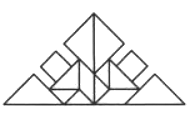 (a) 28
(a) 28
(b) 24
(c) 25
(d) 27
 View Answer
View Answer 
Ans: (c)
Q3: Mr Nitin's class went to the museum on the fourth Tuesday in November 20XX. On what date did his class go to the museum?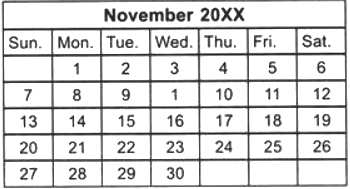 (a) November 4
(a) November 4
(b) November 16
(c) November 22
(d) November 9
 View Answer
View Answer 
Ans: (c)
Fourth Tuesday in November is 22. So, on 22nd November, his class went to the museum.
Q4: There are red and blue balls in a bag. Four-fifth of the balls are red. If we now add 6 red and 6 blue to the bag, which of the following is correct?
(a) There are more blue balls than red balls.
(b) Cannot be determined from given information.
(c) There are the same number of red and blue balls.
(d) There are more red balls than blue balls.
 View Answer
View Answer 
Ans: (d)
Step 1
- It is given that four-fifth balls are red and rest are blue.
- Since, four-fifth is greater than half, there are more red balls than blue balls.
Step 2
- Now same number of red and blue balls are added.
- Therefore, even after adding more balls, there will be more red balls than blue balls.
Q5: How many triangles are there in this figure?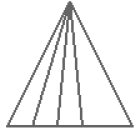 (a) 8
(a) 8
(b) 10
(c) 7
(d)11
 View Answer
View Answer 
Ans: (b)
Following triangles are there in this figure: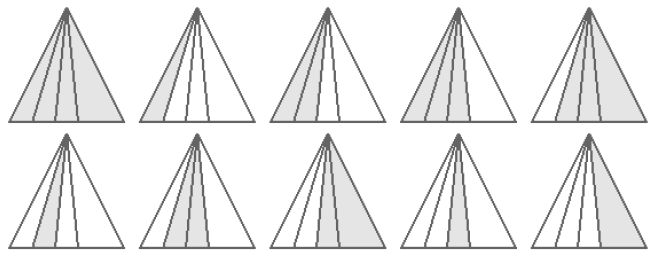 We see that there are 10 triangles in this figure.
We see that there are 10 triangles in this figure.
Q6: Jacob mixed up some single digit numbers in the box shown below. Write the fraction representing the total number of 1's among the given numbers.
(a) 2/7
(b) 1/6
(c) 2/6
(d) 2/5
 View Answer
View Answer 
Ans: (b)
We can see that there are 24 numbers in the box.
Now, lets count number of 1 in the box,
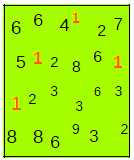
Total number of 1 in the box = 4
The fraction representing the total number of 1's among the given numbers = 4/24=1/6
Q7: Arijit correctly remembers that he visited Punjab before thirteenth of August but after ninth of August . His sister Trishika correctly remembers that Arijit visited Punjab after eleventh of August but before fourteenth of August . On which date of August did Arijit visit Punjab ?
(a) 11th
(b) 12th
(c) 10th
(d) 13th
 View Answer
View Answer 
Ans: (b)
Arijit visited Punjab after 9th and before 13th August, which means he could visit on 10th, 11th, or 12th. Trishika states he visited after 11th and before 14th, leaving only 12th as the valid date.
Q8: Arrange the following in a meaningful order?
- Table
- Tree
- Wood
- Seed
- Plant
choices:
(a) 4, 3, 2, 5, 1
(b) 4, 5, 2, 3, 1
(c) 2, 5, 3, 4, 1
(d) 1, 2, 4, 5, 3
 View Answer
View Answer 
Ans: (b)
The correct order starts with a seed (4), which grows into a plant (5), then becomes a tree (2). The tree is made of wood (3), which is used to make a table (1). Thus, the sequence is 4, 5, 2, 3, 1.
Q9: Read the given information carefully and answer the question that follows.
(i) Aanya enjoys chocolate and mango ice-creams but dislikes butterscotch ice-cream.
(ii) Shanaya prefers mango and butterscotch ice-creams but does not like vanilla ice-cream.
(iii) Manya likes mango and vanilla ice-creams but is not fond of chocolate ice-cream.
(iv) Kavya does not enjoy butterscotch ice-cream."
Which ice-cream is favored by the majority of the girls among the four?
(a) Chocolate
(b) Mango
(c) Vanilla
(d) Butterscotch
 View Answer
View Answer 
Ans: (b)
- The information reveals the preferences of four girls regarding different ice-cream flavors.
- Aanya, Shanaya, and Manya all like mango ice-cream, making it the most popular choice.
- While Aanya likes chocolate, and Shanaya likes butterscotch, neither of these flavors is favored by the majority.
- Thus, mango is the flavor liked by the most girls, confirming it as the correct answer.
Q10: A group of friends went to a carnival. They played different games: Anna played darts, Ben played basketball, Clara played ring toss, and David played the shooting game. If Clara played before Ben and Anna played after David, who played the ring toss game?
(a) Anna
(b) Ben
(c) Clara
(d) David
 View Answer
View Answer 
Ans: (c)
From the information given:
- Clara played before Ben, so Clara must have played the ring toss game before Ben played basketball.
- Anna played after David, which means David played his game before Anna played darts.
Thus, the order of the games is:
- David (Shooting)
- Clara (Ring Toss)
- Ben (Basketball)
- Anna (Darts)
Therefore, Clara played the ring toss game.
Science
Q11: Use the figure to select the correct option from the codes given below:
(a) (i) Windpipe, (ii) Gullet, (iii) Small intestine, (iv) Large intestine
(b) (i) Oesophagus, (ii) Stomach, (iii) Large intestine, (iv) Small intestine
(c) (i) Gullet, (ii) Liver, (iii) Large intestine, (iv) Small intestine
(d) (i) Oesophagus, (ii) Stomach, (iii) Small intestine, (iv) Large intestine
 View Answer
View Answer 
Ans: (d)
(i) is oesophagus, (ii) is stomach, (iii) is small intestine while (iv) is large intestine.
Q12: Study the food chains given below carefully:
Grass → Goat → Man
Leaves → Giraffe → Lion
Papaya → Fruit fly → Lizard
Which of the following statements holds true for the given food chains?
(a) 1 and 2
(b) 2 and 4
(c) 1 and 3
(d) 3 and 4
 View Answer
View Answer 
Ans: (c)
- Food chains illustrate the flow of energy from one organism to another. In this case, the correct answer is (c) 1 and 3, which indicates that the first and third food chains are valid.
- The first chain shows how grass is consumed by a goat, which is then eaten by a man, demonstrating a typical herbivore to carnivore relationship.
- The third chain illustrates how a papaya is eaten by a fruit fly, which is then preyed upon by a lizard, showing a similar energy transfer.
- Options 2 and 4 do not accurately represent valid food chains, making (c) the correct choice.
Q13: Question: X is an organ where digestion of food and absorption of nutrients takes place. Identify X.
(a) Liver
(b) Pancreas
(c) Small intestine
(d) Stomach
 View Answer
View Answer 
Ans: (c)
- Small intestine is the primary organ responsible for the digestion of food and the absorption of nutrients.
- It is a long, coiled tube where most of the nutrient absorption occurs after food is broken down in the stomach.
- The liver and pancreas assist in digestion but are not the main sites for absorption.
- The diaphragm is a muscle involved in breathing, not digestion.
Q14: Select the correct statement regarding the source of water on Earth.
(a) Ponds hold about 70% of all the water on Earth.
(b) No water exists beneath the surface of the Earth.
(c) The Earth has much more salt water than fresh water.
(d) Most of the Earth’s water is stored in large lakes.
 View Answer
View Answer 
Ans: (c)
- The Earth is primarily covered by water, with about 97% being salt water found in oceans.
- Only about 3% of the Earth's water is fresh water, which is essential for drinking and agriculture.
- While glaciers do store a significant amount of fresh water, the majority of the water on Earth is indeed salt water.
- Thus, the correct statement is that the Earth has much more salt water than fresh water.
Q15: In which of the following devices is the wheel and axle not utilized?
(a) Door knob
(b) Skateboard
(c) Car
(d) See-saw
 View Answer
View Answer 
Ans: (d)
- Wheel and axle is a common mechanism found in many machines, but not all devices use it.
- A door knob, skateboard, and car all incorporate the wheel and axle system for movement or operation.
- In contrast, a see-saw operates on a different principle, using a pivot point rather than a wheel and axle.
- Thus, the correct answer is (d) See-saw, as it does not utilize the wheel and axle mechanism.
Q16: Sonia served a thali containing rice, butter roti, fruit salad, and aaloo subji to her friend Meena. Which important component of the balanced diet did she miss in it?
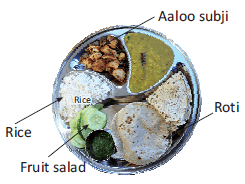 (a) Protein
(a) Protein
(b) Vitamins
(c) Fat
(d) Carbohydrates
 View Answer
View Answer 
Ans: (a)
She missed protein.
Q17: Select the incorrect statement regarding a wooden spoon.
(a) It has a definite shape.
(b) It has a definite volume.
(c) It can be compressed.
(d) It is a bad conductor of electricity.
 View Answer
View Answer 
Ans: (c)
- Wooden spoons are known for their definite shape and volume, meaning they maintain their form and size.
- They are not compressible, which means they cannot be easily squished or reduced in size.
- Additionally, wooden spoons are poor conductors of electricity, making them safe to use in cooking.
- Thus, the statement that a wooden spoon can be compressed is incorrect.
Q18: Identify the part ‘X’ in the given figure?
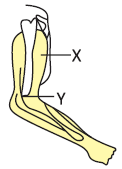 (a) Blood
(a) Blood
(b) Bone
(c) Organ
(d) Muscle
 View Answer
View Answer 
Ans: (d)
The part ‘X’ in the given figure is a muscle. Various muscles in our body form the muscular system and helps in movement of body and body parts.
Q19: Monalisa classified living organisms based on their body coverings. She created four groups of three organisms each but mistakenly included one incorrect member in each group. Identify the incorrect member of each group and select the accurate statement about them.
Group I: Gecko, Python, Anteater
Group II: Snail, Parakeet, Oyster
Group III: Dove, Sparrow, Hippopotamus
Group IV: Hedgehog, Porcupine, Tortoise
(a) Anteater of group I should be interchanged with oyster of group II.
(b) Snail of group II should be interchanged with porcupine of group IV.
(c) Hippopotamus of group III should be interchanged with hedgehog of group IV.
(d) Parakeet of group II should be replaced with clam.
 View Answer
View Answer 
Ans: (d)
- The anteater in Group I is a mammal, while gecko and python are reptiles, making it the odd one out.
- In Group II, the snail is a mollusk, while parakeet and oyster are not, indicating a mismatch.
- Group III has dove and sparrow as birds, but hippopotamus is a mammal, so it doesn't belong.
- In Group IV, hedgehog and porcupine are mammals, while tortoise is a reptile, which is correct.
- Thus, the parakeet in Group II should be replaced with a clam, which is a mollusk, to maintain consistency.
Q20: The given diagram shows the relative composition of the air. The X and Y represent _____ and _____ respectively?
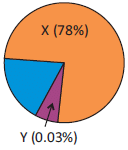 (a) Carbon dioxide, nitrogen
(a) Carbon dioxide, nitrogen
(b) Nitrogen, inert gases
(c) Nitrogen, carbon dioxide
(d) Oxygen, carbon dioxide
 View Answer
View Answer 
Ans: (a)
X is nitrogen while Y is inert gases.
Q21: Read the following statements and select the option which correctly identifies the true (T) and false (F) ones.
(i) The last two pairs of ribs are called floating ribs.
(ii) Motor nerves carry messages from the sense organs to the brain or the spinal cord.
(iii) Cerebrum is the largest part of the human brain.
(iv) Medulla controls many necessary involuntary activities of the body.
(a) F T F T
(b) F T F F
(c) T T T F
(d) T F T T
 View Answer
View Answer 
Ans: (d)
- Statement (i) is true because the last two pairs of ribs do not attach to the sternum and are known as floating ribs.
- Statement (ii) is false; motor nerves actually carry messages from the brain or spinal cord to the muscles, not from sense organs.
- Statement (iii) is true as the cerebrum is indeed the largest part of the human brain.
- Statement (iv) is true because the medulla oblongata regulates involuntary functions like breathing and heart rate.
Q22: Smriti matched one kharif crop with one rabi crop as follows: Rice : Mustard. Choose the option that pairs crops in the same way as Smriti.
(a) Wheat : Pea
(b) Chickpea : Oat
(c) Soybean : Gram
(d) Cowpea : Maize
 View Answer
View Answer 
Ans: (c)
- The question asks for a pairing of crops similar to Smriti's example of a kharif crop (Rice) with a rabi crop (Mustard).
- Kharif crops are typically sown with the onset of the monsoon, while rabi crops are sown in winter.
- Among the options, Soybean is a kharif crop and Gram is a rabi crop, making option (c) the correct pairing.
- The other options do not match the kharif and rabi classification correctly.
Q23: Now a days Pluto is not considered a planet because............. .
(a) It has stopped burning
(b) Bits of light is reflected from its surface
(c) Its orbit is irregular
(d) It is considered on ultra-large planet
 View Answer
View Answer 
Ans: (c)
Pluto, which was earlier considered a planet was placed in a separate category called ‘dwarf planets’ by the International Astronomical Union (IAU) in August 2006.
Q24: Identify the group that contains one example each of the three types of rocks and select the correct option.
(a) Granite, Pumice, Slate
(b) Obsidian, Sandstone, Marble
(c) Limestone, Conglomerate, Quartzite
(d) Slate, Gneiss, Basalt
 View Answer
View Answer 
Ans: (b)
- Obsidian is an example of an igneous rock, formed from cooled lava.
- Sandstone represents a sedimentary rock, made from compacted sand particles.
- Marble is a type of metamorphic rock, created from limestone under heat and pressure.
- This option (b) includes one example of each rock type, making it the correct choice.
Q25: In a large forest with many kinds of animals, there is only a small number of bears. Which of these most likely limits the population of bears in the forest?
(a) Supply of food
(b) Type of tree
(c) Predation by carnivores
(d) Amount of suitable shelter
 View Answer
View Answer 
Ans: (a)
The supply of food limits the population of bears in the forest.
Q26: The given figure shows a lunar eclipse. In case of a solar eclipse, the positions of _______ and _______ should be interchanged.
Read the given statements and select the option that correctly fills any three blanks.
(i) Air pollution can be reduced by using________.
(ii) _______is one of the active volcanoes present in the world.
(iii) A person who studies earthquakes is called _______.
(iv) Revolving storms that develop above oceans/seas are called________in Southern USA.
(v) _______are caused due to undersea earthquakes.
(a) (i) - Catalytic converters, (ii) - Mount Erebus, (iv) - Hurricane
(b) (iii) - Anthropologist, (iv) - Typhoon, (v) - Landslides
(c) (i) - Electrostatic precipitator, (iii) - Seismologist, (v) - Droughts
(d) (ii) - Mount Popa, (iv) - Typhoon, (v) - Tsunamis
 View Answer
View Answer 
Ans: (a)
- Air pollution can be effectively reduced by using catalytic converters, which help in cleaning exhaust gases.
- Mount Erebus is a well-known active volcano located in Antarctica.
- In the context of storms, the term hurricane refers to the revolving storms that form over warm ocean waters, particularly in the Southern USA.
Q27: A list of various actions is given below: (i) Terrace farming (ii) Agricultural runoffs entering water bodies. (iii) Sewage disposal into water bodies. (iv) Gas leaking from ACs (v) Volcanic eruption (vi) Burning excessive coal. Which of these actions do not lead to global warming?
(a) (i), (ii) and (iii) only
(b) (i) only
(c) (ii), (iii), (iv) and (vi) only
(d) (iii), (iv) and (v) only
 View Answer
View Answer 
Ans: (a)
- Terrace farming is a method of growing crops on the sides of hills, which does not contribute to global warming.
- Agricultural runoffs and sewage disposal can cause pollution but are not direct causes of global warming.
- In contrast, actions like gas leaks, volcanic eruptions, and burning coal release greenhouse gases that contribute to global warming.
- Thus, the correct answer is (i), (ii), and (iii) only, as they do not lead to global warming.
Q28: Read the given paragraph with a few blanks and select the option that correctly fills these blanks.
"Plants reproduce vegetatively by different means. Plants like ____________ reproduce with the help of leaves, ____________ and _____________ reproduce by stem, and ____________ reproduces by roots. Some like mushrooms reproduce by ____________."
(a) Bryophyllum, Potato, Turnip, Ginger, Spores
(b) Begonia, Onion, Rose, Sweet Potato, Seeds
(c) Bryophyllum, Rose, Potato, Turnip, Spores
(d) Begonia, Potato, Onion, Sugarcane, Seeds
 View Answer
View Answer 
Ans: (c)
- Plants can reproduce in various ways, and the question provides specific examples for each method.
- In the correct answer, Bryophyllum uses leaves for reproduction, while Rose and Potato reproduce through stems, and Turnip reproduces via roots.
- Additionally, mushrooms reproduce using spores, which is accurately reflected in option (c).
- This option correctly matches the methods of vegetative reproduction with the respective plants.
Q29: Sanjana found that as a seed germinates and seedling into young plant the size of the seed leaves gradually become smaller. It is because:
(a) The seed leaves are absorbed back into the seed coat.
(b) The sunlight withers the seed leaves.
(c) The food that seed leaves have, have been used by the growing plant.
(d) None of these.
 View Answer
View Answer 
Ans: (c)
The food that seed leaves have, have been used by the growing plant.
Q30: Polar bears are adapted to live in the Arctic region. Which of these are necessary adaptations for cold habitats?
(i) White fur
(ii) Thick fur
(iii) Thick layer of blubber
(iv) Sharp teeth
(v) Good sight
(vi) Furry paws
Select the correct option:
(a) (ii), (iii) and (vi)
(b) (i), (ii) and (vi)
(c) (ii), (iii), (iv) and (v)
(d) (i), (iii) and (iv)
 View Answer
View Answer 
Ans: (a)
Thick fur, thick layer of blubber and furry paws are the adaptations for animals living in cold habitats.
Q31: Which of these groups of diseases spread by the same means or have the same cause?
(a) Goitre, Anaemia, Scurvy
(b) Dengue, Malaria, Pellagra
(c) Cholera, Typhoid, Allergy
(d) Scurvy, Malaria, Pellagra
 View Answer
View Answer 
Ans: (a)
Goitre, anaemia and scurvy all are non-communicable diseases, which are caused due to deficiency of vitamins or minerals.
Q32: Unscramble the given options to obtain the names of different food preservation methods and select the one using which raisins are preserved.
(a) INIBLGOB
(b) DRYING
(c) CANNING
(d) PICKLING
 View Answer
View Answer 
Ans: (b)
- DRYING is the method used to preserve raisins. It involves removing moisture from the grapes, which prevents spoilage and extends their shelf life.
- Other options like CANNING and PICKLING are different preservation methods but are not used for raisins.
- In DRYING, the grapes are typically dried in the sun or using dehydrators, which concentrates their sugars and flavors.
- This method is effective because it reduces the water content, making it difficult for bacteria and mold to grow.
Q33: Why is it important for our slippers to have a good groove pattern?
(a) To increase friction
(b) To reduce gravity
(c) To decrease friction
(d) To enhance elasticity
 View Answer
View Answer 
Ans: (a)
- Slippers with a well-grooved design provide better traction on surfaces.
- This increased friction helps prevent slipping, making them safer to wear.
- Good grooves allow for better grip, especially on smooth or wet floors.
- Overall, having a good groove pattern is essential for stability and safety while walking.
Q34: Select the incorrect statement about soil erosion.
(a) As a result of soil erosion, the land becomes unproductive.
(b) Planting more trees is an effective way of reducing soil erosion.
(c) Terrace farming and overgrazing can prevent soil erosion in hilly areas.
(d) Embankments check soil erosion by fast-moving rivers.
 View Answer
View Answer 
Ans: (c)
- Terrace farming is a method used to reduce soil erosion on slopes, but overgrazing actually contributes to soil erosion by removing vegetation.
- Soil erosion leads to unproductive land, as it washes away the topsoil which is rich in nutrients.
- Planting trees helps to anchor the soil and reduce erosion, making it an effective strategy.
- Embankments can help control the flow of water in rivers, thus preventing soil erosion along riverbanks.
Q35: A fish live longer in an aquarium with water plants in it, than in one without them because plants
(a) Release carbon dioxide
(b) Release oxygen
(c) Prepare food
(d) Provide more water
 View Answer
View Answer 
Ans: (b)
A fish live longer in an aquarium with water plants in it, than in one without them because plants release oxygen which is taken up by fish.
Q36: What is the term used for sacred groves in Kerala?
(a) Shipin
(b) Oran
(c) Devrai
(d) Kavis
 View Answer
View Answer 
Ans: (d)
- Kavis refers to the sacred groves found in Kerala, which are important for local culture and biodiversity.
- These groves are often dedicated to local deities and are protected by the community.
- They play a crucial role in preserving flora and fauna and maintaining ecological balance.
- Other options like Shipin, Oran, and Devrai refer to sacred groves in different regions or cultures.
Q37: Select the correct match.
(a) Crust - Forms continents
(b) Mantle - Thickest among all layers
(c) Outer core - Hottest among all layers
(d) Inner core - Solid state
 View Answer
View Answer 
Ans: (a)
- Crust is the outermost layer of the Earth and indeed forms continents. This is a correct match.
- The mantle is actually the thickest layer, not the thinnest, which makes option (b) incorrect.
- The outer core is very hot, but it is not the hottest; that title goes to the inner core, making option (c) incorrect.
- The inner core is solid, not molten, which makes option (d) incorrect.
Q38: I painted the inner four walls of a box. Then I put an ice block into it such that it did not touch the walls, but I couldn‘t do the same when I put water in that box. Why?
(a) Liquid takes the shape of the container, so it will always touch the walls of the box in which you put it.
(b) The molecules of liquids are more tightly packed than that of gases.
(c) Both (a) and (b)
(d) Neither (a) nor (b)
 View Answer
View Answer 
Ans: (a)
Liquid takes the shape of container, so it will always touch the walls of the box in which you put it.
Q39: Which of the following statements are true about pelicans?
(i) It lays eggs.
(ii) It has a beak.
(iii) Its body is covered only with scales.
(iv) It has webbed feet that help it to swim
(a) (iii) and (iv) only
(b) (ii), (iii), and (iv) only
(c) (i), (ii), and (iv) only
(d) (i), (ii), (iii), and (iv)
 View Answer
View Answer 
Ans: (c)
- Pelicans are known for their unique characteristics. They lay eggs, which is a common trait among birds.
- They possess a beak, which is essential for catching fish, their primary food source.
- However, their bodies are not covered with scales; instead, they have feathers.
- Pelicans have webbed feet that assist them in swimming efficiently.
Q40: Select the odd one out based on the type of simple machine.
(a) Screw
(b) Fishing rod
(c) Wheelbarrow
(d) Pliers
 View Answer
View Answer 
Ans: (a)
- The screw is a type of simple machine that converts rotational motion into linear motion.
- In contrast, a fishing rod, wheelbarrow, and pliers are not classified as simple machines; they are tools that utilize multiple simple machines.
- Thus, the screw stands out as it is a single simple machine, while the others are combinations of machines.
- This makes the screw the odd one out in this context.
Q41: Study the given Venn diagram. Select on example for L, M and N.
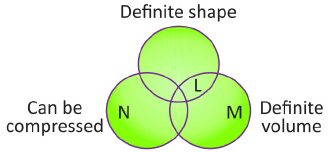
(a) L-Rubber band; M-Oxygen; N-ceramic tile
(b) L-Iron rod. M-Salt; N-Water vapour
(c) L-Syrup; M-Ceramic tile; N-Oxygen
(d) L-Marbic; M-Syrup; N-Nitrogen
 View Answer
View Answer 
Ans: (d)
L is marble (solid), which have definite shape and volume, M is syrup (liquid), which has definite volume and can be compressed while N is nitrogen (gas), which can be compressed.
Q42: What name has been given to the energy which lights up the bulbs in our houses?
(a) Electrical energy
(b) Chemical energy
(c) Atomic energy
(d) Magnetic energy
 View Answer
View Answer 
Ans: (a)
Energy possessed by electricity is called electrical energy. For example, electrical energy lights up the bulbs in our houses.
Q43: Starting from the first letter, eliminate every second letter and identify the method of water purification that uses alum.
(a) CBPOKIDLYIXNNG
(b) ZOISSMKOQSRIDSW
(c) MSYEDDKICMNEPNOTLAVTDIBOCN
(d) IFMINLLTIRKADTPITOWNR
 View Answer
View Answer 
Ans: (c)
- The question asks to strike out every alternate letter starting from the first letter.
- After applying this method, the remaining letters spell out a term related to water purification.
- The correct answer is (c), which refers to a method that involves alum, commonly used in water treatment to help remove impurities.
- Alum acts as a coagulant, helping to clump together particles in water so they can be easily filtered out.
Q44: Which phenomenon of light is depicted in the following figure?
 (a) Refraction
(a) Refraction
(b) Reflection
(c) Wavelength
(d) Optical illusion
 View Answer
View Answer 
Ans: (b)
The figure depicts how rays of light are getting reflected in different directions after hitting rough surfaces.
Q45: The first manned spacecraft that landed on Moon is ___________
(a) Aryabhata
(b) Apollo 11
(c) Sputnik-I
(d) Insat 1A
 View Answer
View Answer 
Ans: (b)
- Apollo 11 was the first manned mission to successfully land on the Moon in 1969.
- This mission carried astronauts Neil Armstrong, Buzz Aldrin, and Michael Collins.
- Neil Armstrong became the first human to set foot on the lunar surface, followed by Aldrin.
- The other options, such as Aryabhata and Sputnik-I, were significant in space exploration but did not land on the Moon.
Achievers Section
Q46: Two students were talking about the given natural phenomena- thunderstorm and lightning. 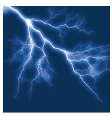
Who according to you is correct?
(a) Students X
(b) Students Y
(c) Both the students are correct
(b) Both the students are incorrect
 View Answer
View Answer 
Ans: (b)
Speed of light is faster than the speed of sound; hence lightening is seen first than thunderstorm.
Q47: Study the given table. Select the option that correctly identifies X, Y and Z.
Select the option that correctly identifies X, Y and Z.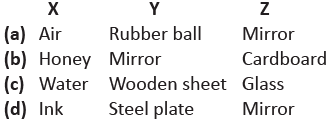
 View Answer
View Answer 
Ans: (c)
Q48: Identify X, Y, and Z in the given flow chart and select the correct statement regarding them.
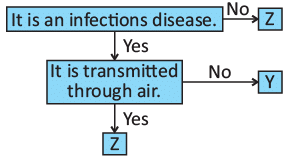 (a) X could be night blindness whereas Z could be plague. (b) Y could be cholera whereas Z could be rickets.
(a) X could be night blindness whereas Z could be plague. (b) Y could be cholera whereas Z could be rickets.
(c) X could be scurvy whereas Y could be dengue.
(d) Y could be malaria whereas Z could be beriberi.
 View Answer
View Answer 
Ans: (a)
Night blindness (X) is not an infectious disease while Plague is a communicable disease that can be transmitted through air.
Q49: Study the given passage.
X, Y, and Z are different parts of the brain. X controls muscular activities, Y controls learning ability and memory, and Z controls activities such as breathing, heartbeat, and blood pressure. Identify X, Y, and Z and select the correct statement regarding them.
(a) X is the upper part of brain that also controls our sense organs.
(b) Y is located below X towards back of the brain.
(c) X is also called brain stem and it works even when we are asleep.
(d) Z connects the brain to spinal cord whereas Y is the largest part of the brain.
 View Answer
View Answer 
Ans: (d)
Z is medulla and connects the brain to the spinal cord. It controls activities such as heartbeat, breathing swallowing and sneezing. Y is cerebrum, the largest part of the brain
Q50: Study the given figure. What does this model demonstrate?
What does this model demonstrate?
(i) Muscles in the arm work in pairs.
(ii) The arm is made of bone and muscles.
(iii) The arm can bend and straighten
(a) Only (i) and (ii)
(b) Only (ii) and (iii)
(c) Only (i) and (iii)
(d) (i), (ii) and (iii)
 View Answer
View Answer 
Ans: (d)
The arm demonstrates the working of muscles and bones. Muscles, by contracting and relaxing, help the bones to move. It helps in the bending and straightening of an arm.
|
37 videos|80 docs|50 tests
|
FAQs on Science Olympiad Model Test Papers - 2 - Science Olympiad for Class 5
| 1. What topics are covered in the Class 5 Science Olympiad Model Test Papers? |  |
| 2. How can students prepare effectively for the Class 5 Science Olympiad? |  |
| 3. What is the format of the questions in the Science Olympiad Model Test Papers? |  |
| 4. Are the Science Olympiad Model Test Papers beneficial for overall science learning? |  |
| 5. How are the results of the Science Olympiad evaluated? |  |
















